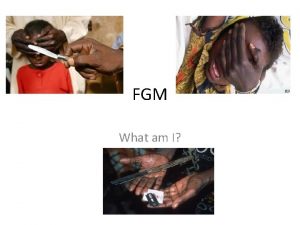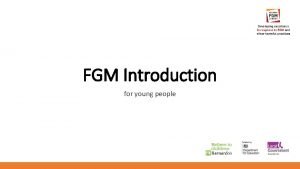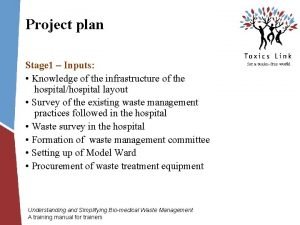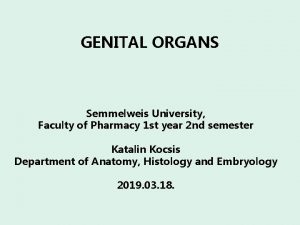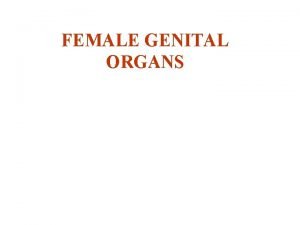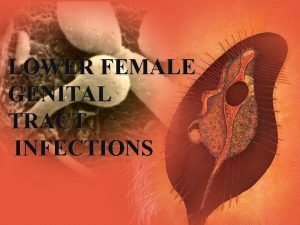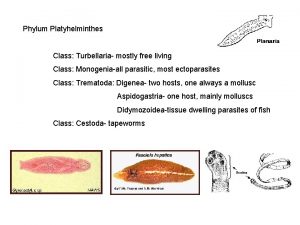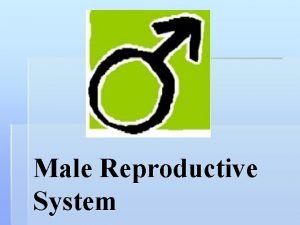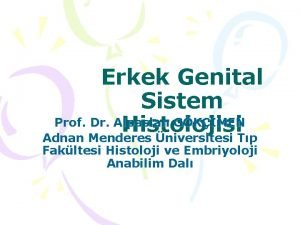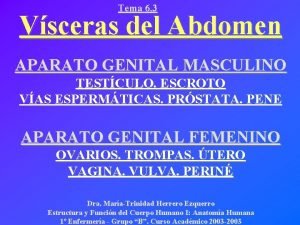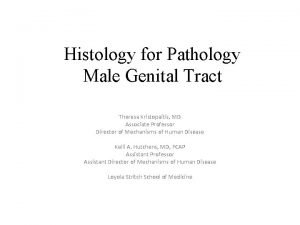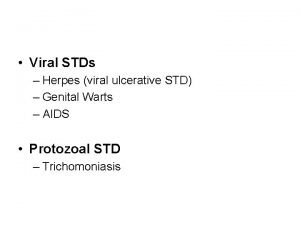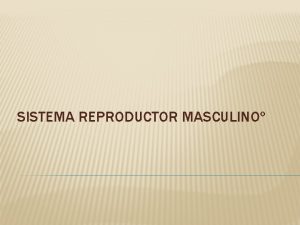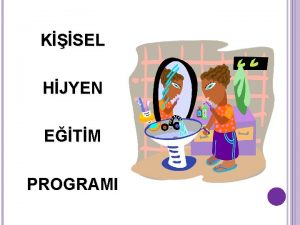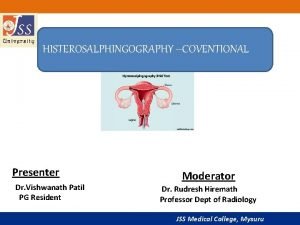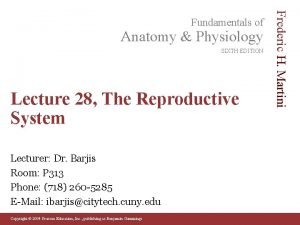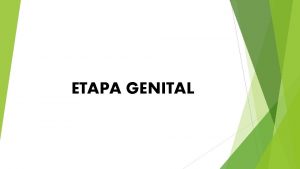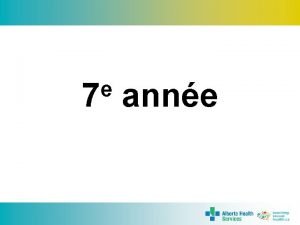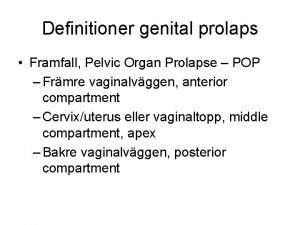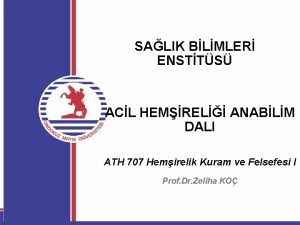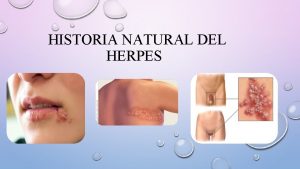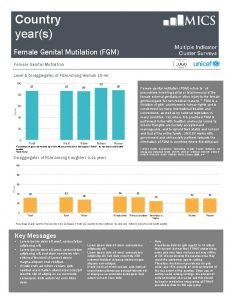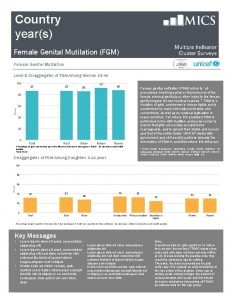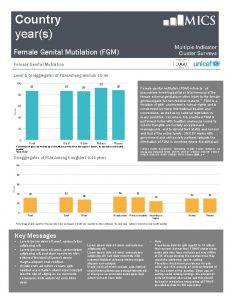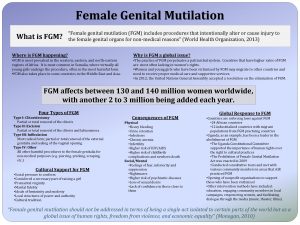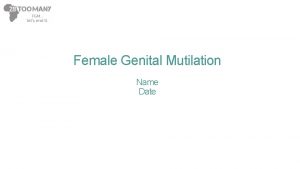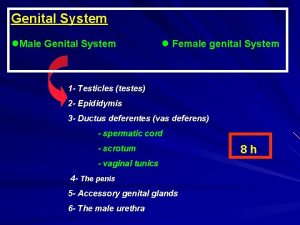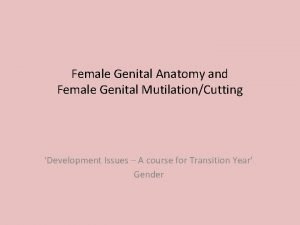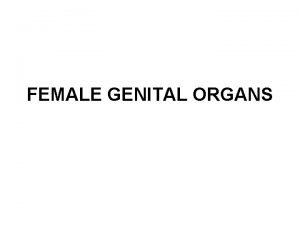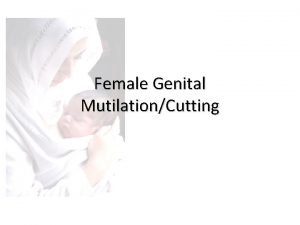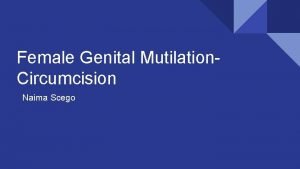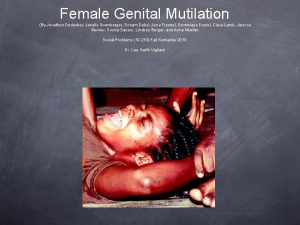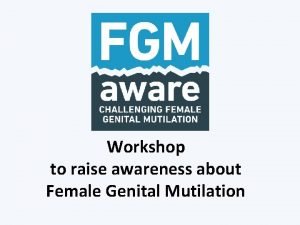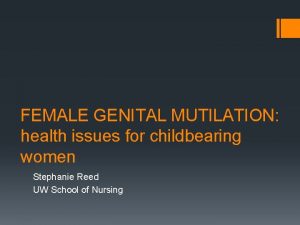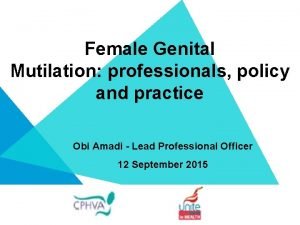THE STATUS OF FEMALE GENITAL MUTILATION PREVENTION IN



































- Slides: 35

THE STATUS OF FEMALE GENITAL MUTILATION PREVENTION IN EUROPE AND A LOOK TOWARD THE FUTURE Anna Powers Advisor: Dr. Tomas Griebling Mentor: Natalie Kontoulis Summer 2015

Project Objectives • To gather information from European nonprofit organizations that focus on female genital mutilation (FGM) prevention about: o The organizations’ structures o FGM laws and statistics in the countries where the organizations are located o Challenges the organizations face in preventing FGM and strategies for overcoming those challenges • To provide a brief US comparison of nonprofit work with FGM prevention

The END FGM European Network • The End FGM European network (END FGM) is a European umbrella organization set up by 11 national NGOs to ensure sustainable European action to end FGM. • Five point strategy consisting of health, data collection, integrating FGM into broader measures on violence against women, protecting asylum seekers and refugees affected by, or at risk of, FGM, and including FGM in the EU’s engagements with the rest of the world

Above: Adriana Bertini with her creation, Mother and Child, at “Auction for Action” Above: Vice President of European Commission Viviane Reding receiving the Campaign’s recommendations and a creation by Brazilian artist Adriana Bertini


BACKGROUND INFORMATION

Motivation • “In the nineteenth century, the central moral challenge was slavery. In the twentieth century, it was the battle against totalitarianism. We believe that in this century the paramount moral challenge will be the struggle for gender equality around the world. ” --Nicholas Kristof & Sheryl Wu. Dunn, Half the Sky

What is FGM/FGC/FC? • According to the World Health Organization, FGM comprises all procedures that involve partial or total removal of the external female genitalia, or other injury to the female genital organs for non-medical reasons. There are four major types. • More than 125 million girls and women alive today have been cut. • FGM is mostly carried out on young girls sometime between infancy and age 15.

• Mostly carried out by traditional circumcisers, who often play other central roles in communities. However, more than 18% of all FGM is performed by health care providers, and the trend towards medicalization is increasing. • Depending on the type of FGM, the procedure can take 20 -30 minutes. Sharp objects, including knives, glass, sharpened stones, and hot coals, are used to make the cuts. • In most cases the instrument used to make the cuts is used on multiple girls and is not cleaned in between uses • In most cases anesthetics and antiseptics are not used

Reasons for FGM • Religion • Sociological: “Rite of Passage” • Cleanliness & Purity • Psychological • Sexual & Marriage Factors • Economic • Tradition

Consequences of FGM • Immediate: • Long-Term: v. Shock v. Bleeding and hemorrhage v. Infection v. Damage to organs v v v v Urinary Tract Infections Extremely painful menstruation Scars and keloid on the vulva Fistula Vulvar abscesses Severe pain during intercourse Complications during child birth, potentially leading to obstructed labor and fetal death or brain damage v Infertility v Blood clots in the uterus and/or vagina v Psychological Problems, including depression and anxiety

FGM & Migration • To date, there is no data collection which would allow for comparison and a European wide vision of the exact extent of the practice of FGM in Europe or of the number of women and girls living in Europe at risk of FGM. • According to a resolution passed by the European Parliament in March 2009 on Combating FGM in the EU around 500, 000 women and girls living in Europe have been subjected to female genital mutilation and 180, 000 are at risk for it each year. • More than half a million women and girls are at risk of undergoing or have already undergone FGM in the United States (Population Reference Bureau)

Ethical Considerations • Cultural relativism vs. universality of human rights • Increasingly complicated as migrant communities bring FGM to countries outside of where the tradition is originally practiced. • The practice violates an individual's rights to health, security and physical integrity, the right to be free from torture and cruel, inhuman or degrading treatment, and the right to life when the procedure results in death. • International Covenant on Civil and Political Rights (ICCPR), International Covenant on Economic, Social and Cultural Rights (ICESCR), Convention Against Torture, Convention on the Elimination of Discrimination Against Women (CEDAW) and Convention on the Rights of the Child (CRC)

PROJECT METHODS & RESULTS

Methods Survey administered to twelve nonprofit organizations associated with the END FGM network. All organizations had some prevention component. Questions assessed: The Organization’s Structure Core Area of Work FGM Prevention Programs in African Employees Year of Creation Building Bridges Program FGM laws and statistics in the country where the organization is located National laws in the organization’s country Whether or not the organization’s country signed/ratified the Istanbul Convention Studies on Prevalence and girls at risk in the organization’s country Populations the organization reached Challenges Strategies


Core Area of Work? Is FGM your Organization's Core Area of Work? 5; 42% Yes 7; 58% No

Prevention Programs 9 Number of Organizations 8 7 6 5 4 3 2 1 0 Youth Education General Education Policy Professional Training Religious/Community Leaders Asylum

Programs in Africa? Does your Organization have Programs in Africa? 5; 42% 7; 58% Yes No

Composition of Staff Are 50% or more of your Organization’s Staff Members from Countries that Practice FGM? Yes No 4; 33% 8; 67%

What Populations do you Reach? Does your Organization work with Women from all of the top 5 Countries of Origin that Women at Risk for FGM in your Country are from? 5; 42% 7; 58% Yes No

Year of Creation Number of Organizations 2 1 0 1967 1982 1983 1990 1994 1995 Year 1996 2000 2001 2009 2014

National Laws against FGM? Does the Country in which your Organization is located have National Laws against FGM? Yes No 12; 100%

The Istanbul Convention Did the Country in which your Organization is located Sign the Istanbul Convention (on Preventing and Combating Violence against Women) Did the Country in which your Organization is located Ratify the Istanbul Convention (on Preventing and Combating Violence against Women) 2; 17% Yes No 10; 83% 6; 50% Yes No

Studies on Prevalence and at Risk Girls? Does the Country in which your Organization is located have a Study to estimate the Prevalence of Women with FGM in the Country? Does the Country in which your Organization is located have a Study to estimate the Number of Girls at Risk for FGM in the Country? 3; 25% 4; 33% 8; 67% Yes No No 9; 75%

Challenges Organizations That cited the challenge Challenges to preventing FGM IN EUROPE 5: APF, MIGS, Equi. Pop, GAMS Belgium, Aki. Dwa Reaching/gaining access to migrant communities in Europe 4: FORWARD, INTACT, GAMS Belgium, FSAN European professionals often know little about FGM and are reluctant to work on FGM because they feel uncomfortable; professionals include healthcare workers, religious leaders, politicians, and legal workers. 3: Female Integrity, Equi. Pop, FORWARD, Getting immigrant groups to accept that FGM is a harmful practice and a legitimate problem, especially in light of other challenges they face like financial struggles. 3: FORWARD, FSAN, GAMS Belgium Lack of government funding. As a result, programs are largely “project based” and lack continuance. 2: Medicos del Mundo, INTACT It is difficult for female migrants to get asylum based on FGM in European countries. 2: Aki. Dwa, FORWARD European media coverage of FGM is often sensationalist and negative (linked with anti-migrant discourse), which discourages anti-FGM sentiment and action in these countries.

1: Aki. Dwa European society in general has a lack of knowledge about FGM; challenging to provide quick, relevant information to the public. 1: APF Little information about the state of FGM in European countries: number of women in Europe who have undergone FGM, number of girls/women at risk for FGM, etc. 1: Medicos del Mundo Overcoming the social pressure migrants often face to undergo FGM/have their daughters undergo FGM when they visit their country of origin. 1: Equi. Pop Connecting migrants with behavioral changes occurring in their country of origin. 1: FORWARD Lack of collaboration between NGOS focused on women’s issues and FGM within each country and Europe in general. 1: GAMS Belgium Teams that focus on FGM prevention are often diverse (from many different countries). Members have different opinions on many issues, which can make finding a common direction difficult.

Reaching/Gaining Access to Migrant Communities in Europe • Mapping migrant organizations • Community health ambassadors/community mediators (migrant women from practicing communities who engage their communities in dialogue around FGM and who disseminate information within their local communities)

Professionals’ Lack of Knowledge • Hold workshops for professionals on FGM • A need to develop better educational tools and ensure implementation of those tools

Getting Immigrant Groups to accept FGM as a Legitimate Problem • Talk with doctors and nurses about FGM and educating patients on its harms • Giving monetary compensation to involved migrants and mobilizing during non-working hours • Sensitization

Lack of Funding • Aim for a diverse source of funding, including partnerships with coalitions and other organizations, to avoid relying on one major source • A need for better structural financing from the government in most European countries (at least 3 year funding intervals)

US Comparison

Conclusions • Most European prevention programs focus on educating professionals and FGM practicing communities • Most European nonprofits do not reach all FGM practicing communities in their country • Top challenges to prevention of FGM in Europe include accessing migrant communities, professionals’ lack of knowledge about FGM, lack of funding, difficulty getting asylum, and sensationalist media coverage • The United States has a less developed network of FGM organizations working to prevent FGM and can learn from Europe as it continues to address FGM.

Acknowledgements • Natalie Kontoulis, Communications and Network Officer at the END FGM European Network • Dr. Fabienne Richard, Executive Director of GAMS Belgium • The END FGM European Network • Dr. Tomas Griebling

Resources • World Health Organization END FGM Fact Sheet (http: //www. who. int/mediacentre/factsheets/fs 241/en/) • END FGM European Network Website (http: //www. endfgm. eu/en/) • Half the Sky by Nicholas Kristof and Sheryl Wu. Dunn • The African Women’s Organization Training Kit: Prevention and Elimination of Female Genital Mutilation among Immigrants in Europe • Council of Europe Istanbul Convention Website (http: //www. coe. int/en/web/istanbul-convention)
 Female genital mutilation
Female genital mutilation Fgm diagram
Fgm diagram Primary prevention secondary prevention tertiary prevention
Primary prevention secondary prevention tertiary prevention Mutilation of waste
Mutilation of waste Pouch of douglas
Pouch of douglas Womans anatomy
Womans anatomy Internal genital organs female
Internal genital organs female Tinedazole
Tinedazole Genital atrium
Genital atrium Semen
Semen Taenia saginata
Taenia saginata Genital infections
Genital infections Oms ciclo vital familiar
Oms ciclo vital familiar Urospermiducte
Urospermiducte Kira nadine first meeting
Kira nadine first meeting Sigmund freud's psychosexual development
Sigmund freud's psychosexual development Male genital variation
Male genital variation Erkek genital sistem histolojisi
Erkek genital sistem histolojisi Patricia castillo anal
Patricia castillo anal Excavatio vesicouterina
Excavatio vesicouterina Male genital tract
Male genital tract Herpes genital glande
Herpes genital glande Genital herpe
Genital herpe Imágenes sistema reproductor masculino
Imágenes sistema reproductor masculino Genital hijyen
Genital hijyen Salphagitis
Salphagitis External genitalia of female
External genitalia of female Dogfish shark phylum
Dogfish shark phylum Etapa genital
Etapa genital Vesicula seminal função
Vesicula seminal função Durée des règles
Durée des règles Cervixelongation
Cervixelongation Erogenous zone of latency stage
Erogenous zone of latency stage Genital hijyen
Genital hijyen Ciclo vital individual
Ciclo vital individual Historia natural del herpes labial
Historia natural del herpes labial
